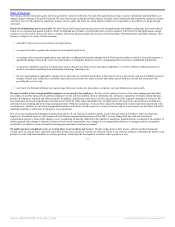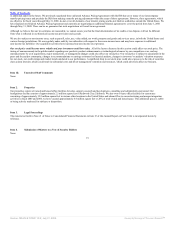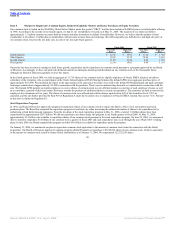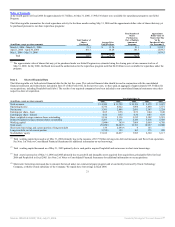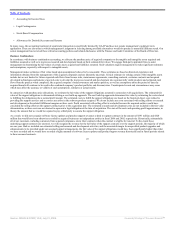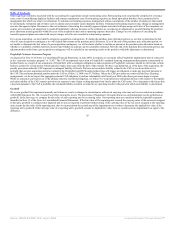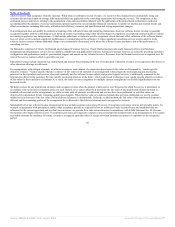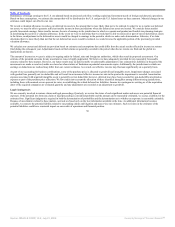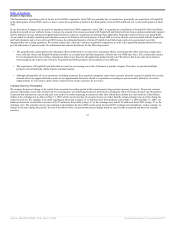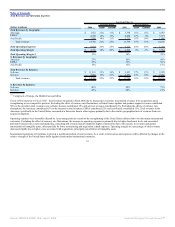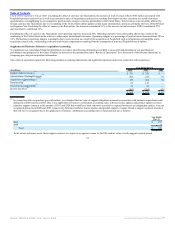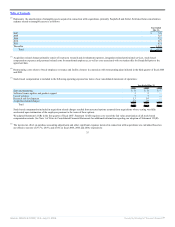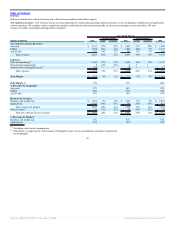Oracle 2005 Annual Report Download - page 30
Download and view the complete annual report
Please find page 30 of the 2005 Oracle annual report below. You can navigate through the pages in the report by either clicking on the pages listed below, or by using the keyword search tool below to find specific information within the annual report.
Table of Contents
Determining the fair value of a reporting unit is judgmental in nature and involves the use of significant estimates and assumptions. These estimates and
assumptions include revenue growth rates and operating margins used to calculate projected future cash flows, risk-adjusted discount rates, future economic and
market conditions and determination of appropriate market comparables. We base our fair value estimates on assumptions we believe to be reasonable but that
are unpredictable and inherently uncertain. Actual future results may differ from those estimates. In addition, we make certain judgments and assumptions in
allocating shared assets and liabilities to determine the carrying values for each of our reporting units. Our most recent annual goodwill impairment analysis,
which was performed during the fourth quarter of fiscal 2006, did not result in an impairment charge.
Revenue Recognition
We derive revenues from the following sources: (1) software, which includes new software license and software license updates and product support revenues,
and (2) services, which include consulting, On Demand and education revenues.
New software license revenues represent fees earned from granting customers licenses to use our database, middleware and applications software, and exclude
revenues derived from software license updates, which are included in software license updates and product support. While the basis for software license revenue
recognition is substantially governed by the provisions of Statement of Position No. 97-2, Software Revenue Recognition, issued by the American Institute of
Certified Public Accountants, we exercise judgment and use estimates in connection with the determination of the amount of software and services revenues to
be recognized in each accounting period.
For software license arrangements that do not require significant modification or customization of the underlying software, we recognize new software license
revenue when: (1) we enter into a legally binding arrangement with a customer for the license of software; (2) we deliver the products; (3) customer payment is
deemed fixed or determinable and free of contingencies or significant uncertainties; and (4) collection is probable. Substantially all of our new software license
revenues are recognized in this manner.
The vast majority of our software license arrangements include software license updates and product support, which are recognized ratably over the term of the
arrangement, typically one year. Software license updates provide customers with rights to unspecified software product upgrades, maintenance releases and
patches released during the term of the support period. Product support includes internet access to technical content, as well as internet and telephone access to
technical support personnel. Software license updates and product support are generally priced as a percentage of the net new software license fees. Substantially
all of our customers purchase both software license updates and product support when they acquire new software licenses. In addition, substantially all of our
customers renew their software license updates and product support contracts annually.
Many of our software arrangements include consulting implementation services sold separately under consulting engagement contracts. Consulting revenues
from these arrangements are generally accounted for separately from new software license revenues because the arrangements qualify as service transactions as
defined in SOP 97-2. The more significant factors considered in determining whether the revenue should be accounted for separately include the nature of
services (i.e., consideration of whether the services are essential to the functionality of the licensed product), degree of risk, availability of services from other
vendors, timing of payments and impact of milestones or acceptance criteria on the realizability of the software license fee. Revenues for consulting services are
generally recognized as the services are performed. If there is a significant uncertainty about the project completion or receipt of payment for the consulting
services, revenue is deferred until the uncertainty is sufficiently resolved. We estimate the proportional performance on contracts with fixed or “not to exceed”
fees on a monthly basis utilizing hours incurred to date as a percentage of total estimated hours to complete the project. We recognize no more than 90% of the
milestone or total contract amount until project acceptance is obtained. If we do not have a sufficient basis to measure progress towards completion, revenue is
recognized
27
Source: ORACLE CORP, 10-K, July 21, 2006 Powered by Morningstar® Document Research℠


